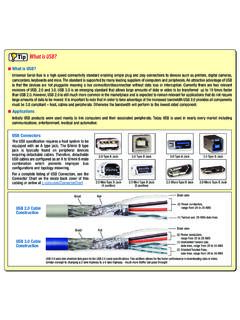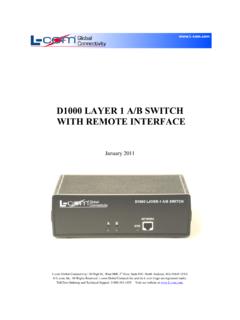Transcription of Surveillance, Security & CCTV: A Buyer’s Guide - L …
1 surveillance , Security & cctv : a buyer s Guide -2- Security surveillance SYSTEMS Security surveillance equipment, more commonly referred to as cctv equipment, is not just for large corporations anymore. Changes in technology and the market have made cctv more affordable than ever. This Guide is a comprehensive overview of the most common options available and how to choose what is best for you. This Guide will sim-plify the available options for cctv . If you have any questions or need further assis-tance, you can visit for an online chat session with a knowledgeable staff member or call toll free 877-538-8685 to speak with a representative in person.
2 Table of Contents Cameras 3 Lenses 5 Digital Video Recorders 7 Accessories 9 10 Wired vs Wireless surveillance -3- Cameras There are a variety of Security cameras available on the market today. They vary with tech-nology, style, and features. Lower priced cctv cameras often use a CMOS (Complementary Metal Oxide Semiconductor) chip whereas higher quality cameras use CCD (Charge Couple Device) chips. Cameras using CMOS technology have less light sensitivity and overall produce a much poorer image compared to cameras using CCD technology. To distinguish between CCD chips manufacturers refer to the size of the chip.
3 You will generally see these noted as 1/4 or 1/3 and sometimes 1/2 . Typically a larger chip will produce a higher quality image. However, as technology is evolving, smaller, more affordable chips are being manufactured that produce high image quality. The style of a camera is refers to the shape and mounting options of a cctv camera. The most common camera styles are dome, bullet, box, PTZ, and covert. Dome cameras are becoming increasingly popular due to their ability to blend in with their surroundings. These cameras are used in residential applications as well as public places such as convenience stores, offices, and lobbies. Though they can be mounted to a wall, they are usually mounted on the ceiling.
4 Bullet cameras are encased in cylindrical usually weather resistant housings. Their size, cost and integrated design make them a great choice for home and outdoor installations. Box cameras can be used with or without a housing. In most instances, they are used with a housing and bracket unit for outdoor areas such as parking lots and entry gates. Lenses are purchased separately offering greater flexibility. PTZ cameras are more expensive but offer the operator more control with remote pan/tilt/zoom. These cameras are used primarily when an operator is actively monitoring an area and needs to manipulate the camera. They are popular in department stores, casi-nos and government buildings.
5 Covert or Spy cameras are designed for discreet installations. They are commonly re-ferred to as a nanny cam. Used frequently by private investigators, they effectively cap-ture video without others being aware. Camera Specifications One of the most common differences between cameras is the resolution offered. Camera resolution is measured by the number of horizontal lines the camera chip produces. It is re-ferred to as TV lines or TVL. The more lines of resolution, the higher the image quality. Stan-dard quality is from 380 TVL to 420 TVL. High quality is from 420 TVL to 480 TVL. Very high quality is anything above 480 TVL. Cameras are available with a wide range of features such as infrared technology, weather-proof housing, vandal proof housing, and various mounting options.
6 -4- Camera Specifications continued Lux is the SI unit of luminous emittance used in photometry as a measure of the apparent intensity of light hitting or passing through a surface. IR cameras have a 0 lux rating as they illuminate in total darkness. Some cameras are known as Day/Night and have very low lux ratings indicating it needs only a small amount of light to capture images in darkness. The chart below is an example of how much light is produced from certain sources measured in lux. If a camera has a lux rating of and gets light equivalent to that of a full moon, it will be able to produce an image. Infrared technology (IR) refers to the cameras ability to capture images in total darkness.
7 Cameras featuring IR product color images during daylight and switch to black and white at night. When choosing this feature, you will want an accurate measure of the distance you need illuminated at night. Some cameras are equipped with more IR lights than others and therefore are capable of producing longer range images at night. Daytime 200 lux Day/Night lux Infrared 0 lux Full Sunlight 50,000 lux Streetlight 5 lux Overcast Sky 5,000 lux Security Lighting 2 lux Office Lighting 500 lux Clear Full Moon lux Hallway / Emergency Lighting 50 lux Moonlit Cloudy Night lux Sunset 10 lux Moonless Starry Night lux Lux Light Level Chart -5- Camera Specifications continued The IP Code or International Protection rating classifies the degrees of protection provided against the intrusion of solid objects, dust, and water in electrical enclosures.
8 The first num-ber you see in an IP rating indicates the effectiveness against intrusion from foreign objects and dust. The second number indicates its effectiveness to protect from the ingress of water. The scale goes from 0-6 for each digit. If you are planning to install outdoor cameras, you will want to use those with an IP 66 rating. This indicates the camera is weatherproof and is safe for outdoor installations. Vandal proof cameras are those that are tamper resistant. They are enclosed in aluminum or special polymer housings that provide protection in locations such as convenience stores where the camera could be tampered with or hit with an object.
9 Mounting options are available if standard mounting does not suit your needs. Many brackets are available including pole mount, ceiling mount and corner mount brackets. Having these options increases flexibility when configuring your field of view coverage. Lenses A lens is an optical device which transmits and refracts light. When choosing the proper cctv camera lens, you must consider the following: Varifocal or Fixed are the two basic types of lenses. Varifocal lenses are adjustable whereas fixed lenses are not. Varifocal lenses are more expensive but are ideal in places where the focal point may change or vary.
10 Fixed lenses typically come as a or 4mm an accom-modate most scenarios. -6- Lenses continued Field of View Chart If you know the distance from where your camera will be mounted to the area you want to monitor, you can better determine what lens you need. If you want to monitor an area 30ft by 40ft and it is 50ft away, using the chart above, you can determine you will need a lens. 5ft 10ft 25ft 50ft 100ft 200ft x x x x x x x x x x x x x x x x x x x x x x x x x x x x x x x x x x x x x x x x x x 75mm x x x x x x 6mm 12mm 60mm Focal Length is measured in mm.















